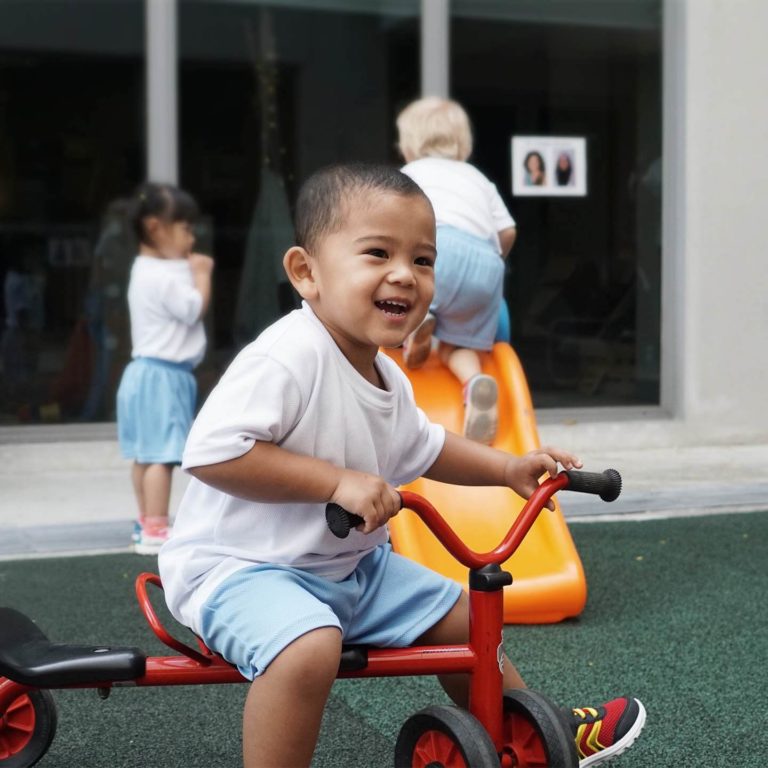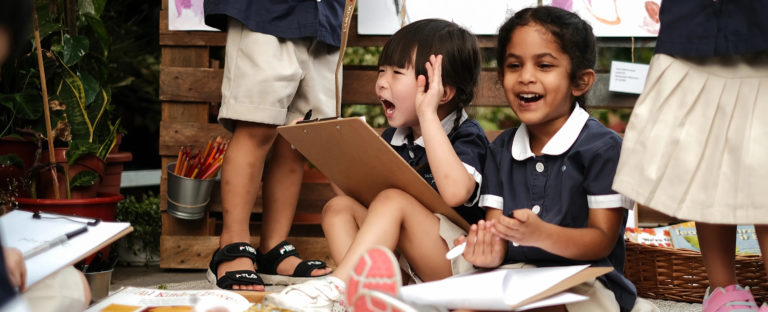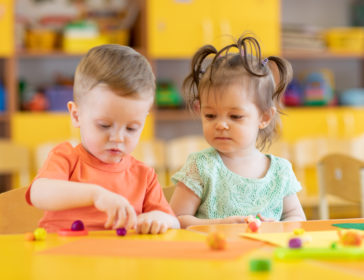
Learn
- SINGAPORE
Reggio Emilia Preschools And Schools In Singapore
Reggio Emilia In Singapore

The Reggio Emilia teaching approach is named after the city in Italy where it was founded. The creator was Loris Malaguzzi, who developed the program after World War II when schools were being rebuilt and updated after many schools were destroyed. In the rebuild, parents and teachers worked together to create a program that encompassed more critical thinking and collaborative learning.
The United States began to adopt the Reggio Emilia method after it was introduced in 1987 to the annual conference of the National Association for the Education of Young Children. The teaching method then spread to other areas in the world, like Singapore. Unlike other very set curriculums with defined teaching policies, the Reggio Emilia approach is quite flexible in the way that establishments follow the teaching guidelines.
The schools in Singapore that adopt the approach, therefore, do it in their own way to cater to Singapore and expat students.
-
What is included in the Reggio Emilia Curriculum?
How It WorksThe fundamental principles of this mode of teaching are based on the assumption that children are capable of creating their own learning processes without too much interference from adults. This means that the curriculum of the Reggio Emilia method is very much open to children pursuing their strong interests and using their exploration as valuable time to learn. Children are encouraged to be their own teachers, first and foremost. Learn more about the values which underpin Reggio Emilia here.
-

The Reggio Emilia Classroom Environment
Fostering Social Interactive LearningThe environment where the student is learning (namely, the classroom and school itself) is often referred to in the Reggio Emilia method as the ‘third teacher,’ where children make sense of their world through how they interact with their environment.
The pre-school environments are generally designed in wide-open spaces which contain a lot of natural light and usually easy access to outdoor play areas. The classroom is created to be a common area where children are able to move about the space and interact with one another.
There is also a lot of hands-on learning materials like toys, blocks, and more. Like other classrooms, you’ll find display walls where the students' work is shared. Additionally, other areas will contain the more long-term projects that are accessed to continue to be worked on (like growing plants, for example).
-
The Teachers of Reggio Emilia Singapore
To Facilitate The Child's LearningThe educator is often described less as a teacher and more of the ‘facilitator’ of the children’s learning. They are there to listen to the child’s needs, answer their questions, and explore what their interests are. They then provide them with opportunities to explore their interests, with the learning projects being created based on what is shared (rather than pre-planned). The teachers who work with this method in Singapore all follow these guidelines.
-

The Benefits of Reggio Emilia Singapore
Why So Many People Choose This Method- With the child-entered approach to learning, your children will feel seen and heard, and this validation of their experience can promote more active engagement in their learning.
- For children with short attention spans, this teaching style is well-suited to their changing interests and questions.
- Children’s social skills are strongly developed in this environment as there is more discussion, collaboration, and interaction with the teacher and other students than traditional learning methods.
- Curiosity, a child’s natural state, is nurtured, leading to general wellbeing and happiness in the child as they are encouraged for their questions, not told to be quiet.
- It fosters a strong connection to the world around them, including natural environments, as children are encouraged to interact with the spaces that they are in and learn from what is in front of them.
-
Featured

Mulberry Learning: Reggio Emilia Preschools And Schools In Singapore
Reggio Emilia And Habits Of Mind CertifiedThis school has been voted Singapore’s “Best Holistic Programme” for a few years in a row. This is due to their comprehensive model offering children a bilingual learning experience. After your young ones go through their infant care program, they will move on to the preschool that incorporates both the Reggio Emilia method and the Habits of Mind framework. This unique framework hails from the US, and Mulberry Learning is the only certified preschool in Singapore to offer this regime. Learn more about Habits of Mind and how it can work with the Reggio Emilia learning philosophy here. There are currently 18 Mulberry Learning preschools around the island, with their newest preschools at Tai Seng and Clarke Quay.
Mulberry Learning, 18 locations across Singapore, +65 6653 8082, enquiry@mulberrylearning.com, www.mulberrylearning.com
-

Australian International School: Reggio Emilia Preschools And Schools In Singapore
One Of The Leading Reggio Emilia School In SingaporeThe unique curriculum of AIS draws on the principles of Reggio Emilia philosophy, which places the child at the center of the learning experience. The learning spaces on campus guide each child’s exploration of the world around them, celebrating their ideas in mathematics and literacy, music and movement, or learning a new language. Teachers work with students to develop their innate wonder and develop their love of learning. The inquiry-based approach of the IB Primary Years Programme is introduced from 3 years old, providing the foundation for success in Elementary School.
Australian International School Singapore, 1 Lorong Chuan Singapore 556 818, tel: +65 6517 0247, admissions@ais.com.sg, www.ais.com.sg/
-

XCL World Academy: Reggio Emilia Preschools And Schools In Singapore
Leading To Outstanding Student Diploma ResultsThe nursery learning center at the XCL World Academy school in Singapore has been inspired by the Reggio Emilia method. The school (formally known as the GEMS World Academy) features modern facilities with many different sports centers, small class sizes for personalized learning, and expert teachers. They pride themselves on developing successful students that reach IB Diploma results well above the world’s average scores. Your children can stay at this school from 2 years old all the way to 18 years old.
XCL World Academy, 2 Yishun Street 42, Singapore, +65 6871 8809, admissions@xwa.edu.sg, www.xwa.edu.sg/#
-

Stamford American International School: Reggio Emilia Preschools And Schools In Singapore
Including Unique Infant CareThis school caters to children from 18 months to 18 years of age, taking them through their whole schooling journey. At the Early Learning Village, the Reggio Emilia approach has inspired the hands-on, child-centric approach. They have natural wooden structures, open classroom spaces, and a teaching environment based on facilitating your child’s interactive, self-guided learning. This approach is taught to children from 2 months to 6 years old, with the added services of infant care for busy parents.
Stamford American International School Early Learning Village, 3 Chuan Lane, Gate 4, Singapore, +65 6602 7247, admissions@sais.edu.sg, www.sais.edu.sg/
-

Lily Valley International Preschool: Reggio Emilia Preschools In Singapore
Cultivating Collaboration In A Diverse CommunityLily Valley International Preschool is a non-profit organization committed to establishing and maintaining a warm, inclusive, and stimulating learning environment for children. Their philosophy and pedagogy is child centered and nurtures children’s potential and creativity by providing rich learning environments for exploration. They are a preschool that cultivates collaboration and participation in a diverse community with meaningful partnerships with children and families.
Lily Valley International Preschool,
Marina Square, 6 Raffles Boulevard #02-27/28,
Singapore 039594, +65 6980 8250, info@lilyvalley.io, www.lilyvalley.com.sg -

Sir Manasseh Meyer International School (SMMIS): Reggio Emilia Preschools And Schools In Singapore
Affordable And Small Class SizesThe indoor sensory gym of the preschool at SMMIS is designed to foster Reggio Emilia style education for young children. They begin educating children from 18 months old in this early learning section and continue with their studies up to 16 years. The school is intentionally small and affordable for people of all nationalities and religious backgrounds to feel welcome and nurtured. Along with their collaborative education model, they provide state-of-the-art facilities like a rooftop swimming pool, science labs, art and drama spaces, a sports hall, and more.
Sir Manasseh Meyer International School, 3 Jalan Ulu Sembawang, Singapore, +65 6331 4633, admissions@smm.edu.sg, www.smmis.edu.sg/
-

Bucket House Preschool: Reggio Emilia Preschools And Schools In Singapore
A More Recent Inclusion To Singapore's PreschoolsThis preschool is all about nurturing young minds through curiosity and open-format child-centric learning. The preschool was founded in 2018 by Amber Koh. She is a strong advocate for outdoor nature-based learning and the Reggio Emilia teaching method. With the balance of structure integrated into the inquiry-based curriculum, the overall experience that children have at Bucket House Preschool is supportive, encouraging, and warm. The wooden structures of the spaces, both indoor and outdoor, give an organic feel to the classroom environment. You’ll find a lot of greenery in the inclusion of beautiful plants, too. Nature-lovers appreciate this Singapore preschool.
Bucket House Preschool, 39 Woodlands Cl, #01-62 Mega at Woodlands, Singapore, +65 6909 8373, enquiry@buckethousepreschool.com, www.buckethousepreschool.com
Additional Info:
Additional Reggio Emilia Schools In Singapore
- Hundred Thought Preschool, 456 Alexandra Road, Fragrance Empire Building #04-01, Singapore, +65 81599 396, admin@hundredthoughtspreschool.com, www.hundredthoughtspreschool.com/
- Blue House International, Nursery & International Preschool, 2 Turd Club Road, Singapore, +65 6734 0824, enquiries.tc@bluehouseinternational.com, www.bluehouseinternational.com/
- UWC South East Asia, Dover Campus, 1207 Dover Road, Singapore 139654. East Campus, 1 Tampines Street 73, Singapore, +65 6260 0602, uwcseaeast@uwcsea.edu.sg, www.uwcsea.edu.sg/
- Middleton International School, West Coast, 20 Harbour Drive, Queenstown, Singapore Central, Singapore, +65 6636 1155, tampines@middleton.edu.sg, www.middleton.edu.sg/
- EtonHouse Broadrick, 51 Broadrick Road, Marine Parade, Singapore East, Singapore, +65 6746 3333, enquiry@etonhouse.com.sg, www.etonhouse.edu.sg/Get More Info:ITS offers independent advice on all areas relating to school choice. We typically work with families who are relocating to or within Singapore, in addition to local families who have reached the natural point of choosing an education path for their child. The comprehensive School Search Service offers expert, independent advice to enable you to choose the most appropriate school for your child.
ITS Education Asia, www.itseducation.asia/singapore/
Want More?
Little Steps Asia knows what families need.
Sign up for our email newsletters to get the most out of Asia!
-
Singapore
You’re Invited To A February Open House At The Australian International School Singapore
Save The Date: February 6, 20252025 Feb 06 - 2025 Feb 06 -
Singapore
Join A January Open House At SJI International Preschool
Save The Date: January 18, 20252025 Jan 18 - 2025 Jan 18 -
Singapore
Best Of New Year’s Eve Events In Singapore With Kids 2025
New Year’s Eve & New Year’s Day Fun! -
Singapore
Experience The Future Of Learning At XCL Academy’s Open House
Save The Date: January 15, 20252024 Jan 15 - 2024 Jan 15 -
Singapore
Join A January Elementary School Open House At Stamford American International School In Singapore
Save The Date: January 17, 2025 From 10AM - 12PM2025 Jan 17 - 2025 Jan 17 -
Singapore
KidsFest 2025 Singapore: Bringing The Magic Of Theater To Young Audiences
Win A Set Of Four Tickets To See The Very Hungry Caterpillar!2025 Feb 06 - 2025 Feb 06 -
Singapore
GIVEAWAY: WIN Four Tickets To Disney On Ice Presents Find Your Hero!
A Magical Medley Of Classic And Modern Tales Including Encanto, Moana And Frozen -
Singapore
*HOT OFF THE PRESS* Gracie Abrams’ Singapore Concert 2025 – Unmissable Tour!
Grammy-nominated star live here!2024 Dec 05 - 2025 Apr 04 -
Singapore
Top Family-Friendly Events 2024: December Activities In Singapore
Explore Kid-Friendly Fun and Adventures All Month Long2024 Dec 01 - 2024 Dec 31 -
Singapore
Top Christmas & Year-End Events In Singapore 2024 That Will Blow Your Mind!
Explore The Best Holiday Fun For The Whole Family!2024 Nov 01 - 2025 Jan 02
SIGN UP
Singapore Tips, Deals + Events.
SHOP! Singapore Gift Guide 2024
BOOK UP: Unique AirBNBS Around KL!
Got kids? Little Steps Asia gives you the scoop on all the things to do and see with babies, toddlers, and kids in Hong Kong, Singapore, Kuala Lumpur, Bali, Jakarta, Macau, and beyond. From family-friendly hotels, kids and baby shops, the best schools and after school activities, pregnancy tips and meet-ups and more – we have you sorted.
Sign up to receive the free Little Steps email newsletter packed with news, offers, and hidden treasures for Singapore families.

© 2024 Little Steps Asia. All rights reserved.

















